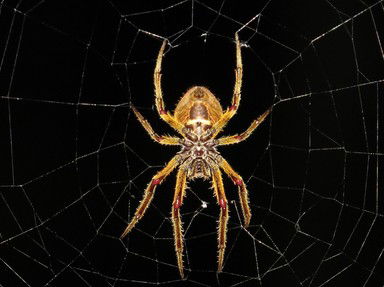Quiz Answer Key and Fun Facts
1. Spinnerets are silk-producing organs located on a spider's abdomen. Within these structures, does the silk generally come from a single orifice or multiple orifices?
2. Spiders breathe oxygen, just like the large majority of organisms in the kingdom Animalia. However, they do it not through their mouths, but through small openings on their abdomen. The oxygen then goes to what organ, so-named because it has page-like flaps?
3. A spider's principal eyes (one large pair in the front) and secondary eyes (multiple smaller pairs) all see the same thing and perform identical functions.
4. Generally speaking, how do the webs built by funnel-web spiders differ from those built by orb-weaving spiders?
5. A spider's chelicerae are used to hold prey and inject venom (and sometimes digestive enzymes that help break down body tissues). Which of the following best describes the spider's actual mouth?
6. What is the main factor that allows the family Salticidae (jumping spiders) to propel themselves so far?
7. In most spider species, males need to perform a dance or courtship ritual to avoid being eaten.
8. Taking a close look at the image, what is this bolas spider attempting to do?
9. What defense mechanism have New World tarantulas developed to protect themselves from larger predators?
10. Lovingly named for a character from "The Jungle Book," what astonishing fact about the spider species Bagheera kiplingi is true?
Source: Author
trident
This quiz was reviewed by FunTrivia editor
rossian before going online.
Any errors found in FunTrivia content are routinely corrected through our feedback system.
